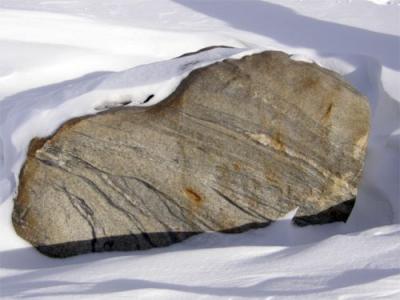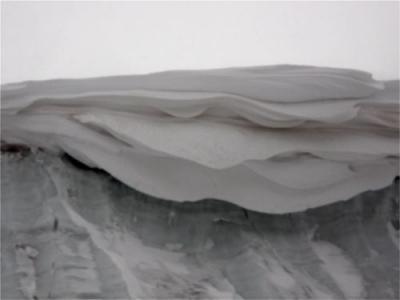"The wind evaporated the ice just as fast as it arrived. In one of nature's greatest magic tricks, the glaciers in the Dry Valleys vanish into thin air." This quote comes from Paul Doherty's website after his visit to the Commonwealth Glacier in 2002.
The Commonwealth Glacier was named for the Commonwealth of Australia which funded part of Scott's 1910-1913 expedition, and contributed two members to the Western Geological Party which explored this area.
We worked hard to finish packing for our trip back to McMurdo so we would have time for a hike today. Packing does not involve putting clothes in a bag. Packing involves putting "rudders" on snowmobiles and hooking them with cables in the correct places so the helicopters can pick them up.

Snowmobile ready for helicopter pickup
It involves sandwiching Sieglin sleds around strings of flights and the Scott tent and wrapping this giant red sausage in a helicopter sling.

I'm hooking the sled sandwich for the helicopter pickup
It involves packing triple-thick cardboard boxes (tri-walls) with tables, chairs, tents, poop buckets, spill kits, generators, etc. as densely as possible on top of a pallet which is centered over a giant sling for the helicopter pick-up and then strapping it all together with giant cable straps. It involves putting all the fuel drums on pallets over slings, and ditto with used propane tanks, etc. It is a lot of work to pack up a camp!
We ended up with nine sling loads and two passenger loads having to be flown out of New Harbor. You can see how expensive it is to work in Antarctica.
We finished at 4 pm and started walking, in each others footsteps again, to the Commonwealth Glacier, about 2 hours away.

Stacy, Bryan and Marcus got warm enough hiking to unzip Big Red
As we hiked, we noticed some of the patterns of nature around us

Snow and blown silt make beautiful swirling patterns

"Scratch" patterns on upper sides of mountain, and slump pattern at base
Do you have any ideas about how these different patterns form?
We also observed the rocks. They were primarily intrusive igneous rocks like granite.

Granite with large imbedded crystals called phenocrysts

This is a nice gneiss, a metamorphosed granite showing its stripes
We also saw a few sedimentary rocks, including this one large one.

2 meter tall and wide block of sandstone showing erosion features
Now, we were getting closer to the glacier and focused on its cliff edge. Polar glaciers are characterized by the base being frozen and the top moving over it and breaking off, which keeps the cliff face sharp.

View looking up the main valley at the Commonwealth Glacier margin

Me at the Commonwealth Glacier

Bryan gives a sense of scale for the Commonwealth Glacier margin
Notice the cornice at the upper right of this photo. The next image is a close-up of that same cornice.

Close-up of cornice overhanging the top of the cliff wall
It was so windy next to the glacier, we couldn't stay long. But Stacy spent some time just contemplating the immensity of the glacier.

Stacy contemplating the glacier, Antarctica and life!
On the way home, the sun hit an iceberg that broke off the continent but is now stuck in the sea ice.

Iceberg stuck in the sea ice of McMurdo Sound
Maybe the sea ice will melt enough later this season that the iceberg can be on the move again.

